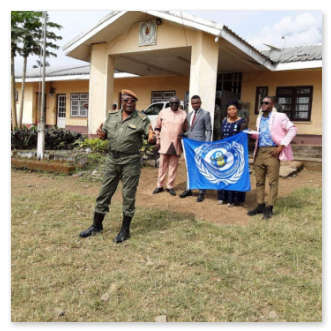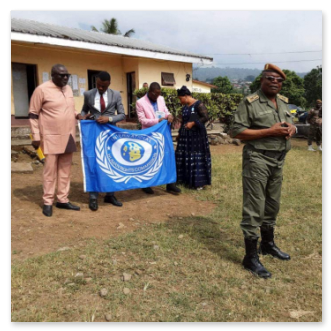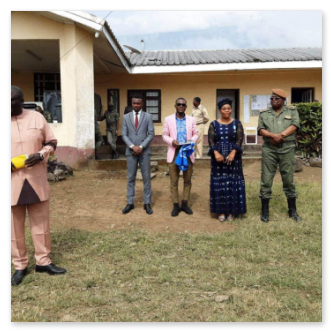UNITE! IHRC Joins Int'l Community in taking Action Against GBV
Missions > Actions > Human Rights > Woman Rights are Human Rights
 UNITE! IHRC Joins Int'l Community in taking Action Against GBV
UNITE! IHRC Joins Int'l Community in taking Action Against GBVCameroon: 16 Days of Activism Against Gender-Based Violence kicks off on the 25th of November - the International Day for the Elimination of Violence against Women - and Human Rights Day on the 10th of December. This global campaign with the theme “UNITE! Activism to end violence against women and girls” calls for more action to prevent and end violence against women and girls by breaking down barriers that rob them of their power.
In commemoration of the 16 Days of Activism Against Gender-Based Violence, the International Human Rights Commission in Cameroon under the leadership of H.E. General Mama Lamya Ngangjoh, IHRC High Commissioner for the Central African Region, organized a campaign against gender-based violence at the National School of Penitentiary Administration, ENAP Buea where he presides as the Commander and Director. The program was organized to raise awareness of violence against women and girls and ways to address it.
Over 200 correction officers and prison administrators were reached. After a brief explanation of the mission and vision of the International Human Rights Commission (IHRC) by the South West Zonal Coordinator, Mr, Ayuk Georges, H.E. General Ngangjoh opened the session by highlighting that Gender Based Violence (GBV) is a universal reality existing in all societies regardless of socio-economic status, culture or any other form of diversity. He pointed out as well that many women and girls have been, and still are experiencing violence which has adversely affected their psychological and bodily health, as well as productivity and participation in their homes, communities, and workplaces.
He added that the widespread violence against women and girls has devastating consequences and demands a collective effort to address it.
The campaign continued with a presentation on the forms and consequences of gender-based violence.
The presentation was done by H.E. Dr. Holy Anagho Asanji who doubles as the National Volunteers Coordinator and Peace Ambassador of the IHRC Cameroon. Her presentation pointed to the principal forms of GBV including; physiological, sexual, psychological, economic, and harmful traditional practices. She also underlined that unwanted pregnancies, sexually transmitted infections, family conflicts, school dropout, injuries, and death were the devastating consequences of GBV.
Barrister Tanga Tomas, an IHRC Special Monitoring Mission Volunteer rounded off the presentations with legal protection of human rights. He pointed out that the most important global human rights instrument is the Universal Declaration of Human Rights, adopted in 1948 by the General Assembly of the UN, and so widely accepted that its initial non-binding character has altered, and much of it is now frequently referred to as legally binding based on customary international law.
He added that the UDHR is the touchstone human rights instrument from which tens of other international and regional instruments, and hundreds of domestic constitutions and other legislation, have drawn inspiration. The UDHR consists of a preface and 30 articles setting forth the human rights and fundamental freedoms to which all men and women everywhere in the world are entitled, without any discrimination. It encompasses both civil and political rights as well as social, economic, and cultural rights.
He also pointed out that violating women's and girls' human rights may break laws and subject the perpetrator to prosecution. As such, when violations occur, it's the government's job to intervene and prosecute those responsibly. At the end of the campaign, Ngangjoh immensely thanked the IHRC team, the staff, and the trainees of ENAP for their massive attendance and urged that the lessons learned from the campaign be put into practice.
Reported
H.E. Gen. Mama Lamya Ngangjoh, IHRC High Commissioner for the Central African Region.
Editorial:
Fidelis Onakpoma
IHRC Editor-in-Chief
The campaign continued with a presentation on the forms and consequences of gender-based violence.
The presentation was done by H.E. Dr. Holy Anagho Asanji who doubles as the National Volunteers Coordinator and Peace Ambassador of the IHRC Cameroon. Her presentation pointed to the principal forms of GBV including; physiological, sexual, psychological, economic, and harmful traditional practices. She also underlined that unwanted pregnancies, sexually transmitted infections, family conflicts, school dropout, injuries, and death were the devastating consequences of GBV.
Barrister Tanga Tomas, an IHRC Special Monitoring Mission Volunteer rounded off the presentations with legal protection of human rights. He pointed out that the most important global human rights instrument is the Universal Declaration of Human Rights, adopted in 1948 by the General Assembly of the UN, and so widely accepted that its initial non-binding character has altered, and much of it is now frequently referred to as legally binding based on customary international law.
He added that the UDHR is the touchstone human rights instrument from which tens of other international and regional instruments, and hundreds of domestic constitutions and other legislation, have drawn inspiration. The UDHR consists of a preface and 30 articles setting forth the human rights and fundamental freedoms to which all men and women everywhere in the world are entitled, without any discrimination. It encompasses both civil and political rights as well as social, economic, and cultural rights.
He also pointed out that violating women's and girls' human rights may break laws and subject the perpetrator to prosecution. As such, when violations occur, it's the government's job to intervene and prosecute those responsibly. At the end of the campaign, Ngangjoh immensely thanked the IHRC team, the staff, and the trainees of ENAP for their massive attendance and urged that the lessons learned from the campaign be put into practice.











